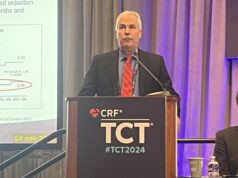Six-month clinical data for Elixir Medical’s bioresorbable scaffold (Desolve) were presented at the 2016 Transcatheter Cardiovascular Therapeutics (TCT) meeting (29 October–2 November, Washington, DC, USA). These data, of the first 25 patients, indicate that at six months, the rate of late lumen loss was 0.18 ± 0.29 mm (“excellent” according to a press release), no cases of scaffold thrombosis, and no (0%) clinically-driven major adverse cardiac events. Imaging results by intravascular ultrasound (IVUS) demonstrated low neointimal volume obstruction of 5%.
IVUS also showed an increase in scaffold and lumen volume between baseline and six months, also confirming early uncaging of the vessel. The press release notes that excellent acute scaffold strut apposition and embedding was observed with intravascular optimal coherence tomography (OCT) imaging. The patients were enrolled in Europe and Brazil, and will continue to be followed-up through two years. The six-month results of the entire study population will be presented after follow-up completion.
Alexandre Abizaid (The Instituto Dante Pazzanese de Cardiologia, Brazil) and Stefan Verheye (ZNA Middleheim Hospital, Antwerp, Belgium) are the co-orincipal investigators of the DESolve Cx international study. Abizaid says: “The trial results position DESolve Cx as a strong next-generation bioresorbable scaffold system providing physicians with a promising product to improve clinical outcomes in a broad patient population. I am confident that Elixir’s DESolve Cx Coronary Scaffold System has the potential to become a work-horse product that will be competitive with the best-in-class drug-eluting stent systems in the clinic, and have the added advantage of being completely resorbed into the body and return vessels to a de novo state.”
The DESolve Cx clinical trial is a 50-patient, single-arm, multicentre, evaluation of the Elixir’s thin-strut (120µm) Desolve Cx novolimus-eluting bioresorbable scaffold (degrades within one year). The primary imaging endpoint of the study is in-stent late lumen loss assessed by quantitative coronary angiography at six months. The primary clinical endpoint is major adverse cardiac events (MACE), a composite of cardiac death, target vessel myocardial infarction, and clinically-indicated target lesion restenosis at six months. Secondary endpoints include MACE at 30 days, and 12 and 24 months; in-segment late lumen loss, binary restenosis, and percent diameter stenosis by QCA; in-scaffold percent volume obstruction and malapposition with IVUS (intravascular ultrasound); and in-scaffold percent obstruction and strut coverage with OCT (Optical Coherence Tomography).
According to the press release, the unique attributes of the DESolve Cx scaffold system include its ability to (a) demonstrate lumen area increase at six months demonstrating vascular restoration; (b) degrade within one year designed to eliminate late scaffold-related events; (c) maintain radial strength and vessel support for the necessary period of vessel healing while degrading; and (d) have a wide margin of expansion.










